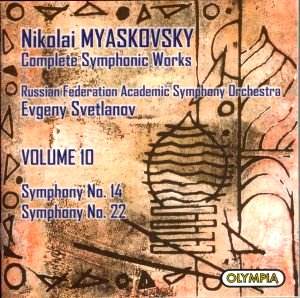This is the world premiere recording of the Fourteenth
Symphony - a work written in the oppressive milieu of state edicts that
musical works must reflect socialist realism. After the morose and gloomy
Thirteenth the Fourteenth's folksy artlessness was more in keeping with
the political correctness of the times. Miaskovsky's use of five movements
also suggested less of a grim symphonic mien; something closer to a
suite. The first three movements and the finale are strongly folk-Rimskian
like symphonies 18, 23 and 26. The fourth movement shivers, emulating
the nocturne from Ravel's Rapsodie Espagnole and then sculls
through the same cloud-darkened waters as Eugene Goossens' By the
Tarn and parts of Van Dieren's Chinese Symphony. This is
still one of Miaskovsky's lighter efforts with the character, if not
the exact impress, of Prokofiev's writing in his first and last symphonies.
The RFASO's brass strike the mot juste with a tone that is half
blurt and half raspberry splendour.
The Twenty-Second (also termed ‘Symphony-Ballad’) will
be known to Miaskovskian old hands from ages gone. They will know it
from the EMI-Melodiya ASD LP of circa 1971 to the late 1980s Olympia
reissue with Feigin's excellent version of the Violin Concerto. It is
a superb work, burnished and radiant with baritonal Russian spirit.
The orchestra plays with fervour. The gripping playing of the strings
and defiant nobility of the brass deserve special mention. I suggest
you ignore the wartime mottos attached to each of the three movements
and just absorb the vigour and passion of the playing. The echo-singing
of the heaven-clawing strings in the first movement recalls his first
'war symphony' (the masterly Fifth). Another cross-reference can be
found in the accented pizzicato of the finale at 4.09 and 7.49 - for
all the world like Rachmaninov's Symphonic Dances completed within
a year before the Miaskovsky symphony. The vein of desperation, grief
(tangible in the central quasi adagio with its thematic link
to the first movement) and striving nobility can be traced also to the
similarly impressive symphonies 24 and 25. The three movements are played
attacca.
The premieres took place as follows: 14 Moscow, Bolshoi
Theatre Orchestra/Viktor Kubatzky (the dedicatee), 24 February 1935.
22, Tbilisi, conducted by Abram Stasevich, 12 January 1942.
I reviewed
the first five volumes in this momentous and musically rewarding project
about two years ago. With agreeably implacable determination Olympia
issued another four volumes last year. This is the tenth of what will
eventually be seventeen volumes.
Per Skans' programme notes (English, French and German)
remain a definitive presence with illuminating links made between cultural
life and political history.
The Russian Federation Academic Symphony Orchestra
was previously the Russian State SO and before that the USSR State SO.
Its conductors numbered Alexander Gauk (1936-41), Nathan Rakhlin (1941-5),
Konstantin Ivanov (1946-65), Svetlanov (1965-2000) and latterly Vassily
Sinaisky.
The recording qualities running through the digital
parts of the cycle are always good in a grand-hall sort of way; resonant
and lively, though with a tendency to play up the denser string textures.
There is a hint of analogue crowding in the strident pay-off in the
finale of the Symphony No. 22.
As already mentioned, when complete there will seventeen
volumes in this series. Seventeen happens to be the number of characters
in the name 'Nikolai Myaskovsky' and this happy coincidence is exploited
by Olympia putting one character of the seventeen at the foot of the
spine of each disc case. When you have all seventeen in volume number
order Miaskovsky's name will be spelt out on your shelves - a nice though
inconsequential touch.
Two aspects of Miaskovsky displayed in two symphonies:
the Rimskian folk-naif 14th and the deeply serious-heroic 22nd - the
latter developing a swinging-trudging charge similar to that of the
celebrated 21st Symphony.
Rob Barnett
see also Nikolai
MIASKOVSKY A Survey of the Chamber
Works, Orchestral Music and Concertos on Record By JONATHAN WOOLF
THE
FRIENDSHIP OF MIASKOVSKY AND PROKOFIEV A
brief account by Dr David C F Wright
